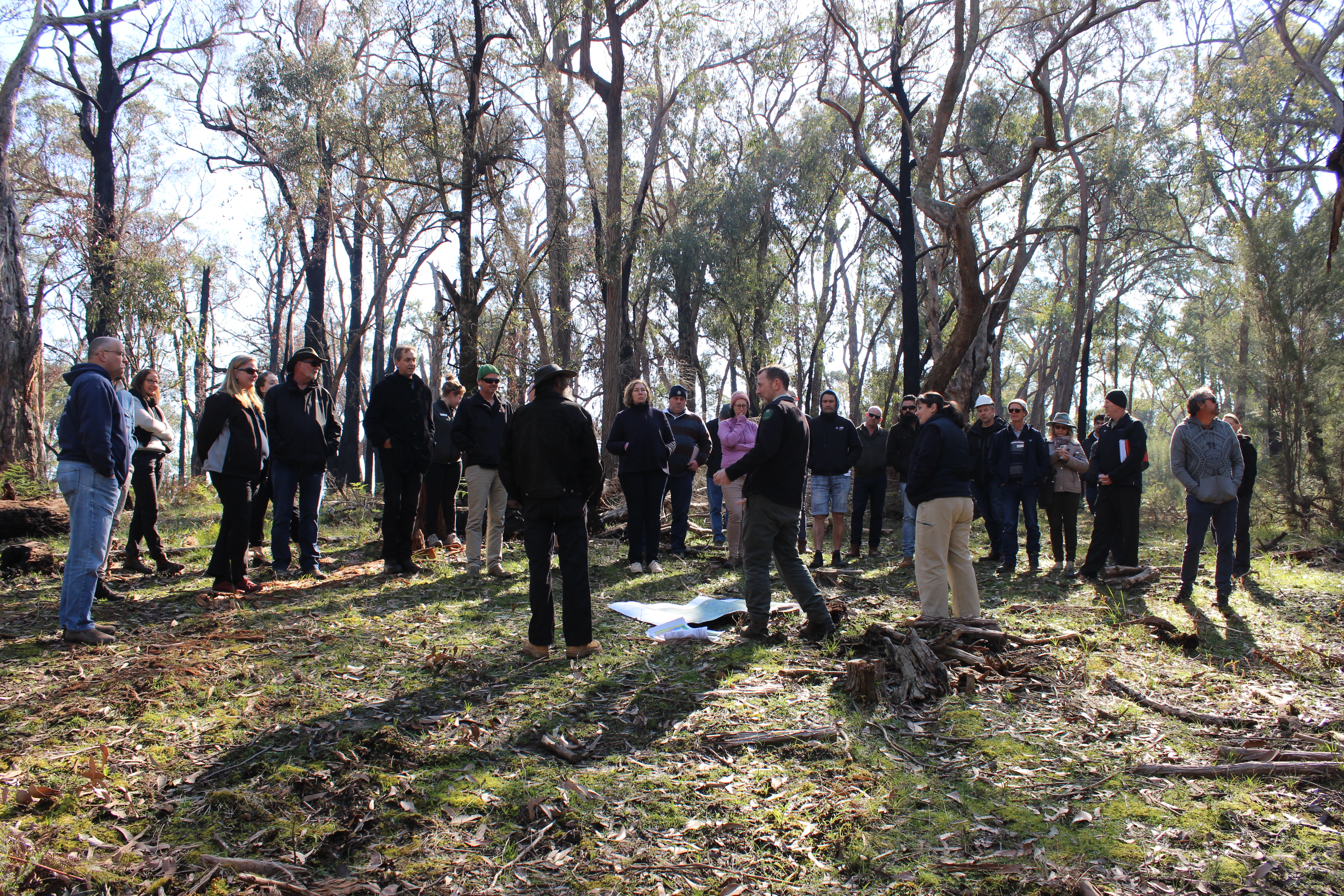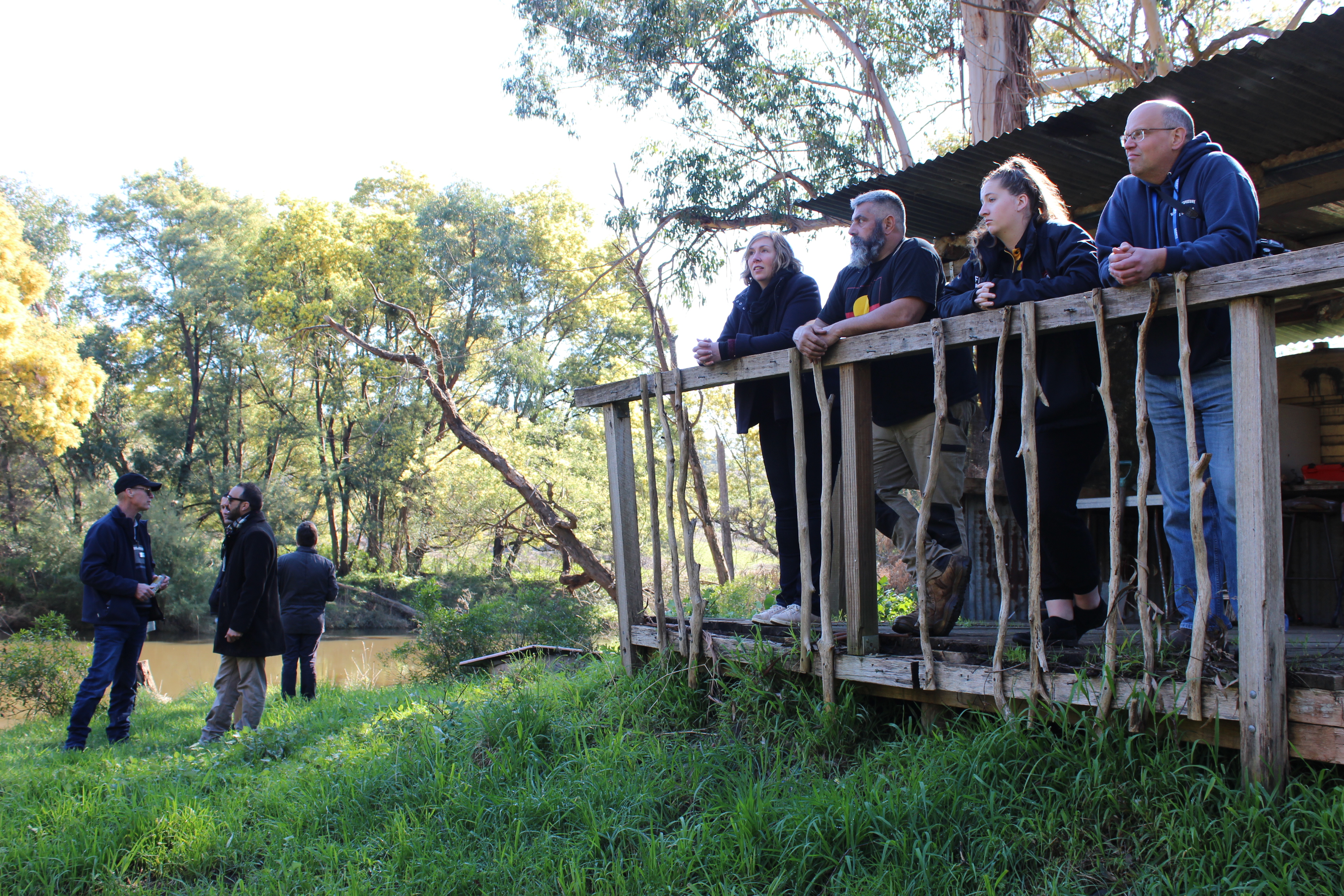Conversations on Country about cultural burning
Recognising the desire to reintroduce Indigenous burning practices onto the Australian landscape – as well as its persisting barriers – a field trip to bring Indigenous and non-Indigenous fire practitioners together was hosted on 30 August 2019 as part of the AFAC19 powered by INTERSCHUTZ Professional Development Program.
Following the AFAC19 powered by INTERSCHUTZ Conference in Melbourne, a group of 40 people travelled to the Yarra Ranges on the city’s outskirts. The field trip provided an opportunity for Traditional Owners, Indigenous fire practitioners and fire and land management agency representatives to walk on Country together while discussing their responsibilities and connection to the land. The group visited two sites; a recent planned burn conducted by Forest Fire Management Victoria for Healesville Sanctuary, and Coranderrk Station, owned by the Wandoon Estate Aboriginal Corporation.
The group, comprising of people from across Australia, New Zealand and Canada, was welcomed onto Country at the gates of Healesville Sanctuary by Uncle David Wandin.
‘Importantly this day is not about fire, it’s about culture. It’s about having conversations about Country, on Country,’ Uncle David said.


At the burn site, Lisa Stuart of Healesville Sanctuary introduced the area to the group, as well as some of the issues they were attempting to address through the burn, such as depleted biodiversity and weed infestations. Uncle David alongside Indigenous fire practitioner Victor Steffensen, provided an assessment of the burn area, pointing to burn marks on the trees and regrowth underfoot to explain of the fire’s short and long-term impacts to the area and its occupants.
‘It’s not just about us, we need to think about what lives under the bark, in the ground, above in the trees. This is much more than just maintaining our safety and burning off bushfire risk, it’s ensuring that we, and everything else that inhabits this area, can come back and live in it,’ Uncle David said.
Uncle David identified the common fear of fire as a major barrier to the implementation of regular ‘cool burning’ to manage landscapes in in Australia.
‘We use the language of war when we talk about fire. We’re “attacked” by fire. We have fire “fighters”. We use big trucks and “bomb” fire from the sky with aeroplanes,’ he said.
‘But if you’re cool burning you should be able to stand next to the flame, it should be low enough that you can step over it. That’s not being a fire “fighter”, that’s working with fire.’
Victor Steffensen said another western mentality that hindered the reintroduction of Indigenous land management practices was the value attributed to science over Indigenous knowledge.
‘Agencies are chasing science, not knowledge. But science is just young knowledge. We’ve done generations and generations of research to know what we know. But it’s our knowledge, our intellectual property, we don’t want to see it published as a science paper with someone else’s name on it,’ he said.
The recurring theme of the field trip was the necessity of strong partnerships between Aboriginal communities and agencies that are grounded in trust to navigate the sensitivities of cultural burning.
Dja Dja Wurrung Clans Aboriginal Corporation Chair Trent Nelson and Forest Fire Management Victoria Assistant Chief Officer Scott Falconer presented The Victorian Traditional Owner Cultural Fire Strategy to the group and shared their journey of reintroducing cultural fire in Central Victoria.
‘We’re talking about fire here, but it’s really about social justice, getting Aboriginal people in employment – employment on Country – and resourcing and skilling up people to do prescribed and cultural burning in line with their family aspirations,’ Trent said.
Scott added that agencies shouldn’t think of Traditional Owners as stakeholders, but partners and leaders in fire management. He also said agencies must be patient when developing these relationships and be willing to hand over some of their responsibility and authority.
‘From an agency perspective you need to establish trust, you can’t assume it. Because why would there be trust? It’s going to take longer, but it’s crucial for these relationships,’ he said.
The group moved to the second site of the field trip to continue the conversation at Coranderrk Station. It was in 2009 when the Black Saturday fires threatened the property that Wurundjeri Elder, Uncle David began his journey into traditional fire management. He shared his vision of creating a demonstration site on the property to showcase how primary producers can work alongside fire and increase their productivity by returning pastoral land to ecology.


CFA State-wide Cultural Heritage Advisor, Michael Sherwen took the opportunity to speak and reiterate the message that Indigenous fire management activities need to be done with the community, by the community and for the community.
‘It’s hard to start these conversations, so we really want to encourage the grassroots communities across Victoria to put their hand up and help us get the right people on board. Let them be a part of it, let it be a part of their Dreaming,’ he said.
Deakin University researcher Dr Timothy Neale contributed his personal experiences of engaging with Indigenous communities through his research projects. He offered his advice to non-Indigenous people engaging with Traditional Owners.
‘Don’t be prescriptive, don’t make promises you can’t keep and be aware of cultural sensitivities and intellectual property. Let yourself be driven by a sense of justice and accept that you don’t know where it will lead, but be willing to share the journey,’ he said.
The field trip provided the participants with an opportunity to break out of their daily routine, gain insight to the methodologies, Lore and holistic approach of Indigenous fire management and have a conversation ‘about Country, on Country’ to help shift their thinking toward new ways of approaching fire management.
Importantly, the field trip empowered the participants to continue the conversation when they returned home, while recognising that the arrangements and partnerships to support the reignition of cultural fire across Australia will be as diverse and unique as the communities involved in their establishment.


